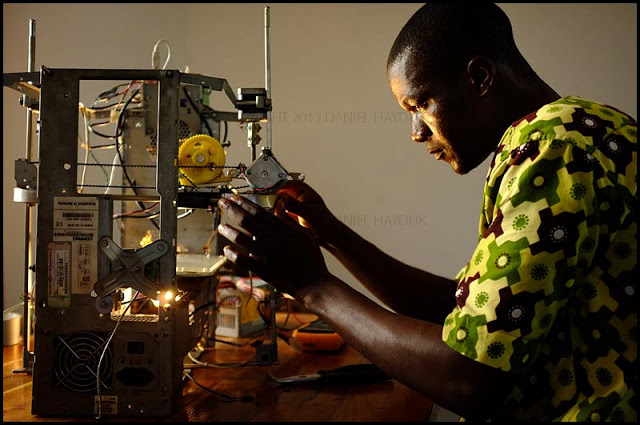(A column highlighting scientific, technological, engineering, and design innovation in Africa)
At 33, Togolese inventor Kodjo Afate Gnikou created the first 3D printer from electronic waste. Afate built the printer for less than US$100, using rails and belts from old scanners, parts of discarded desktop computers (including the case and bits of the diskette drive), as well as printer scraps scavenged from e-waste dumps. He branded the device W.AFATE — “W” for Woe-Lab, the technology incubator in Lome, Togo’s capital, where the printer was built; “AFATE” after his own name.
The W.AFATE 3D printer produces physical objects, lifting designs off a computer. A YouTube video shows it printing a small round container.
W.AFATE was inspired by the Prusal Mendel, a popular printer in the United States and Europe. In 2012, after Woe-Lab members assembled a Prusal Mendel from a kit brought from France, Afate set about creating a made-in-Africa-for-Africa version from parts obtained locally.
It was easy to find the parts. Discarded electronic equipment is one of the world’s fastest-growing sources of waste, as consumers frequently replace “old” models that become more obsolete each year. It already is a huge environmental problem in Africa, where usage of mobile phones and other electronic devices has grown exponentially in the last few years. The massive dump in the Agbogbloshie suburb of Ghana alone collects hundreds of tons of discarded computers and other toxic e-waste from Europe and the U.S. each month. Afate is a staunch advocate of recycling such waste for the social and economic benefit of African households, schools and cyber-cafes.
Woe-Lab bills itself as the first space in Africa dedicated to democratic technology. It took Afate several months to build a workable prototype of his printer. He was able to do so with $4,000 raised via a campaign on Ulule, a European crowdfunding site.
NASA proclaimed W.AFATE the winner of the 2013 NASA International Space Apps Challenge, a competition in Paris for technology designed to get mankind to Mars. The “WAFATE to Mars” entry proposed a larger version of the printer that would be sent to the Red Planet to print tools and homes for future colonization there. Rather than send its e-waste to the poor countries in Africa, Afate proposed, the West could send that waste to Mars, where W.AFATE printers would recycle it to support a human living environment on that planet.
The entry was a collaboration between members of WoeLab-Togo and FacLab-France. “I really want my 3D printer to be the first on Mars so people can say it was an African who had the idea to put a 3D printer on Mars,” Afate said.
Aiming for Mars aside, Afate believes in putting technology into the hands of ordinary Africans, allowing them to create machines to solve the unique problems of their communities, thereby triggering an industrial revolution on the continent.
“Africa, too, has its place on the global market when it comes to technology. We are able to create things,” he said in an interview.













